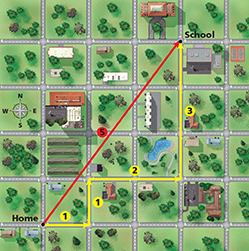Displacement That Isn't Along a Straight Path
When two or more displacement vectors have different directions, they may be combined by graphing. Figure 4 shows vectors representing the movement of a boy walking from his home to school. He starts by walking 1 block east. Then he turns a corner and walks 1 block north. He turns once again and walks 2 blocks east. For the last part of his trip to school, he walks 3 blocks north. The lengths of the vectors representing this path are 1 block, 1 block, 2 blocks, and 3 blocks.
The boy walked a total distance of 7 blocks. You can determine this distance by adding the magnitudes of each vector along his path.
The vector in red is called the resultant vector, which is the vector sum of two or more vectors. In this case, it shows the displacement. The resultant vector points directly from the starting point to the ending point. If you place a sheet of paper on the figure and mark the length of the resultant vector, you see that it equals the length of 5 blocks. Vector addition, then, shows that the boy's displacement is 5 blocks approximately northeast, while the distance he walked is 7 blocks.
Figure 4 Measuring the resultant vector (the diagonal red line) shows that the displacement from the boy's home to his school is two blocks less than the distance he actually traveled.

Section 11.1 Assessment
Reviewing Concepts
 What is a frame of reference? How is it used to measure motion?
What is a frame of reference? How is it used to measure motion? How are distance and displacement similar and different?
How are distance and displacement similar and different? How are displacements combined?
How are displacements combined? A girl who is watching a plane fly tells her friend that the plane isn't moving at all. Describe a frame of reference in which the girl's description would be true.
A girl who is watching a plane fly tells her friend that the plane isn't moving at all. Describe a frame of reference in which the girl's description would be true.
Critical Thinking
Using Analogies Is displacement more like the length of a rope that is pulled tight or the length of a coiled rope? Explain.
Making Judgments Would you measure the height of a building in meters? Give reasons for your answer.
Problem Solving Should your directions to a friend for traveling from one city to another include displacements or distances? Explain.
Inferring The resultant vector of two particular displacement vectors does not equal the sum of the magnitudes of the individual vectors. Describe the directions of the two vectors.
Compare-Contrast Paragraph Write a paragraph describing how the distance you travel from home to school is different from your displacement from home to school. (Hint: Make a simple sketch similar to Figure 4 and refer to it as you write.)




